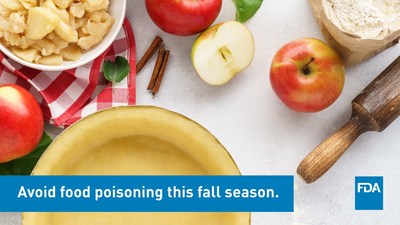SILVER SPRING, Maryland, Oct. 27, 2020 /PRNewswire-HISPANIC PR WIRE/ — As the weather gets cooler, you may find yourself wanting to spend more time baking or cooking in your kitchen or sipping a cup of cider. What better way to get cozy this fall than with a warm treat? To help you safely bake, cook, and enjoy your cider this season, the U.S. Food and Drug Administration (FDA) offers food safety tips that can help you avoid foodborne illness (also known as food poisoning). These tips can help you stay safe in and out of the kitchen, regardless of the season.

When Baking
If you’re baking apple pies, pumpkin bread, or anything in between, you’re likely using flour—and it’s important to remember that flour is a raw food. Many foods made with flour also contain raw eggs. Because these ingredients are raw, they may contain harmful bacteria. Here are a few ways to protect yourself and your family while baking with flour and eggs:
- Never eat or taste raw flour, dough, or batter.
- Follow recipe and package directions on baking mixes and other flour- or egg-containing products for correct cooking temperatures and specified times.
- Keep all raw foods, like flour and eggs, separate from ready-to-eat foods.
Learn more about raw flour and eggs and how to handle these ingredients safely.
When Cooking
Whether you’re experimenting with a new recipe or preparing a meal for family, following these four simple steps can help you keep harmful bacteria from making you and your family sick:
- Clean hands and surfaces often.
- Separate raw meat, poultry, seafood, and eggs from other foods in your grocery shopping cart, grocery bags, and refrigerator.
- Cook food to the right temperature.
- Chill food promptly by refrigerating or freezing meat, poultry, eggs, seafood, and other perishables within 2 hours of cooking or purchasing (or within 1 hour if the temperature outside is above 90° F).
Get more safe food handling tips.
When Drinking Juice or Cider
If you’re planning on enjoying hot apple cider or refreshing fresh-squeezed juice, remember that when fruits and vegetables are fresh-squeezed or used raw, bacteria from the produce can end up in your juice or cider. Here’s what you need to know and do to drink juice and cider safely:
- Unless the produce or the juice have been pasteurized or otherwise treated to destroy harmful bacteria, the juice could be contaminated.
- Look for the warning label stating that the product has not been pasteurized to avoid the purchase of untreated juices. Untreated juice is most likely to be sold in the refrigerated section of a grocery store.
- When preparing juice or cider at home, thoroughly wash your hands and all produce and cut away any damaged or bruised areas on fruits and vegetables. Store the juice and cider in the refrigerator.
Find more tips for preventing illness when purchasing or drinking juice or cider.
Learn more about practicing food safety at home:
- https://www.fda.gov/food/buy-store-serve-safe-food/handling-flour-safely-what-you-need-know
- https://www.fda.gov/food/buy-store-serve-safe-food/what-you-need-know-about-egg-safety
- https://www.fda.gov/food/buy-store-serve-safe-food/safe-food-handling
- https://www.fda.gov/food/buy-store-serve-safe-food/what-you-need-know-about-juice-safety
Contact: Media: 1-301-796-4540 Consumers: 1-888-SAFEFOOD (toll-free)

Photo – https://mma.prnewswire.com/media/1310131/US_FDA_Food_Safety_Tips.jpg
Logo – https://mma.prnewswire.com/media/585467/ucm519149_Logo.jpg
SOURCE U.S. Food and Drug Administration






